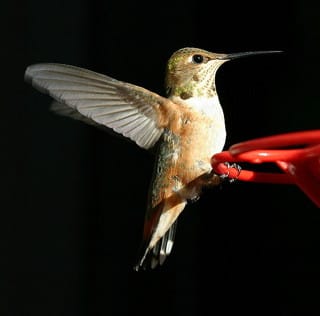Initially this guide displays common birds of all types that are flying right now in our area. Use the selectors below to view rare birds, view birds flying any time, restrict the output to a certain shape of bird, or search by name.
New Mexico is on the western edge of the Central Flyway which is one of the major migration pathways between north and south for birds traveling between breeding and wintering grounds along the Rocky Mountains. This has resulted in the state having an incredible diversity of birds with over 550 different species reported. A little more than half of this number are sighted annually on the Pajarito Plateau. Some of these birds are full-time residents, some migrate here for a few weeks or months, and other are only seen briefly as they pass through the region.
This guide features many of the birds known to frequent Los Alamos county by when they are likely to be seen in the area. You can get additional information on local birds by joining PEEC Birders or going to the eBird website. eBird also includes lists of rare bird sightings and birding hot spots.
Bird References
Birdweb
Cornell Lab of Ornithology
eBird
eNature
Institute for Bird Populations
National Audubon Society
New Mexico Ornithology Society
What Bird
xeno-canto
Subject Area Experts (all guides)
Steve Cary (butterflies)
Beth Cortright (insects)
Terry Foxx (invasive plants)
Leslie Hansen (mammals)
Richard Hansen (fish, mammals)
Dorothy Hoard (butterflies, trees)
Chick Keller (flowers, herbarium)
Shari Kelley (geology)
Kirt Kempter (geology)
Garth Tietjen (reptiles)
David Yeamans (birds)
Web Development and Content Management
Pat Bacha
Jennifer Macke
Graham Mark
Akkana Peck
Contact
Please contact us for local nature questions and sightings. We welcome comments, corrections, and additions to our guides.
For more information about local nature, please visit our Nature Blog or subscribe to PEEC This Week.
Make Selection
 Photo: male by Bob Walker  Photo: female by Mouser Williams .jpg) Photo: female nesting by Brendan Lally |  Rufous HummingbirdRUHU (Selasphorus rufus, Trochilus rufus)Family: Trochilidae (Hummingbirds) Size: 3.5 - 4.8 in (9 - 12 cm) Flies: Jun 15 - Oct 01 Morphology: both sexes have nearly straight bills, tapered tails, and fairly short wings; males are bright copper on back and belly with iridescent red throat; females are green above with rufous-washed flanks, rufous patches on the tail, and often a spot of copper on the throat Status: native; locally common Food source: Mostly nectar and insects; prefer red flowers Habitat: alpine meadows, forest edges Rufous Hummingbirds have the longest migration route of all North American hummingbirds. They travel from Mexico to as far north as Alaska. While they may perch at a hummingbird feeder, they will usually feed while hovering, extending their long tongues to reach deep into the feeder or flower. The first hummingbird to discover a food source, including feeders, defends it. It will perch on a nearby branch and intercept intruders in air with its angry buzzing. They have excellent memories and have been observed looking for a absent feeder that was there the previous year. These hummingbirds are fairly hardy as they can survive temperatures well below freezing given sufficient food and shelter. Males may mate with several females. Females are responsible for making the nest, incubating the eggs, and feeding the young. Nests are well concealed in coniferous trees or deciduous shrubs. Info Photos Distribution Frequency |
